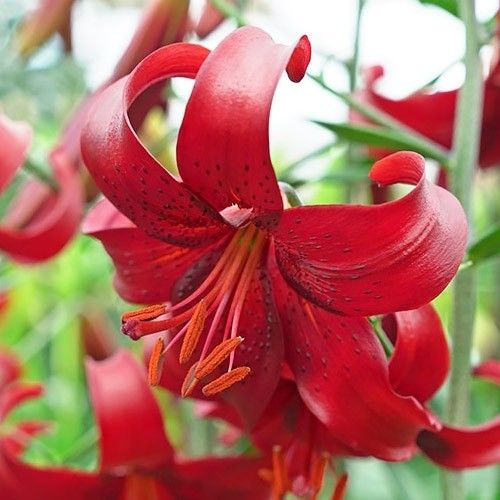
Tiger Lilies
Tiger Lilies
Last Reviews
All About Tiger Lilies: Types, Meaning, and Care Tips
Tiger lilies are beautiful, showy flowers that are known for their bright orange color and black spots, which give them a tiger-like appearance. In this response, Ill cover the different types of tiger lilies, their meaning, and some care tips.
Types of Tiger Lilies:
There are several types of tiger lilies, including:
- Lilium lancifolium: This is the most common type of tiger lily, known for its orange flowers and dark spots.
- Lilium tigrinum: Also known as the Chinese tiger lily, this type has larger, more open flowers than Lilium lancifolium.
- Lilium henryi: This type of tiger lily has smaller flowers than the other two, with a slightly more muted orange color and fewer spots.
Meaning
Tiger lilies have a rich history of symbolism and meaning. Some common meanings associated with tiger lilies include:
Wealth and prosperity: In Chinese culture, tiger lilies are often associated with wealth and good fortune.
Passion and love: Tiger lilies are sometimes used to represent passionate love, particularly in romantic contexts.
Bravery and strength: The bold, striking appearance of tiger lilies can also be associated with qualities like bravery and strength.
Care tips
If you want to grow tiger lilies, here are some care tips to keep in mind:
Planting: Tiger lilies should be planted in the fall, ideally in a spot with full sun or partial shade. Make sure the soil is well-draining and not too wet.
Watering: Tiger lilies need regular watering, especially during the growing season in the spring and summer. Be careful not to overwater, as this can cause the bulbs to rot.
Fertilizing: You can fertilize tiger lilies in the spring with a slow-release fertilizer or by adding compost to the soil around the plants.
Pruning: After the flowers have bloomed, you can cut off the stalks to encourage new growth. In the fall, you can cut the plants back to the ground.
Winter care: Tiger lilies are hardy and can survive cold winter temperatures, but you may want to add a layer of mulch around the plants to protect the bulbs.
The Meaning and Symbolism Behind Tiger Lilies: What Do They Represent?
In many different cultures and traditions, tiger lilies have long been associated with symbolism and meaning. Here are a few of these flowers most typical associations:
- In China, tiger lilies are regarded as a symbol of abundance and good fortune. To wish the happy couple luck, they are frequently used at weddings and other events.
- In Japan, tiger lilies stand for courage and tenacity. They are also seen as a representation of loyalty and friendship.
- Native American cultures hold tiger lilies in high regard for their healing properties and ability to fend off evil spirits. Furthermore, they are used as a form of treatment for a number of illnesses like fever, headaches, and sore throats.
- Tiger lilies are frequently connected in Western cultures to ardor and love. To express admiration, attraction, or desire, they might act in this manner. They can also represent confidence, aspiration, and pride.
Types of Tiger Lilies: A Guide to Popular Varieties and Their Characteristics
Depending on your preferences and climate, you can pick from a variety of tiger lilies. Here are some of the most common varieties along with some information about them:
1. Lilium lancifolium: Found naturally in Asia, this is the original species of tiger lily. It has recurved petals and flowers that are bright orange with black spots. It blooms from July to August and reaches a height of up to 6 feet.
2. Lilium tigrinum: This hybrid variety is the one that is grown most frequently in gardens. Compared to the wild species, it has larger flowers with more spots and colors. It has a 4-foot maximum height and blooms from June to September.
3. Another hybrid variety, Lilium henryi, has orange-yellow flowers with brown spots and green tips. It looks more elegant because its stamens are longer. It blooms from July to September and reaches a height of up to 8 feet.
4. Lilium splendens: This variety has two layers of spotless petals and has double flowers. Its edges are a deep orange color that gradually turns yellow. It has a 5-foot maximum height and blooms from June to August.
Asiatic vs. Oriental Lilies: Differences in Appearance, Care, and More
Tiger lilies belong to the Asiatic group of lilies, which are different from the Oriental group in several ways. Here are some of the main differences between Asiatic and Oriental lilies:
Appearance
Asiatic lilies have smaller flowers with fewer petals than Oriental lilies. They also have more colors and patterns than Oriental lilies, which usually have white or pink flowers with dark spots or stripes. Asiatic lilies have upright stems with leaves all along them, while Oriental lilies have arching stems with leaves only at the base.
Fragrance
Asiatic lilies have little or no fragrance, while Oriental lilies have a strong and sweet fragrance that can fill a room.
Bloom time
Asiatic lilies bloom earlier than Oriental lilies, usually from late spring to early summer. Oriental lilies bloom later, usually from midsummer to early fall.
Care
Asiatic lilies are easier to grow and care for than Oriental lilies. They can tolerate more sun and less water than Oriental lilies, which prefer partial shade and moist soil. Asiatic lilies are also more resistant to diseases and pests than Oriental lilies.
Planting Tiger Lilies: How to Grow These Beautiful Blooms in Your Garden
If you want to grow tiger lilies in your garden, here are some steps you need to follow:
1. Choose a location: Tiger lilies prefer full sun or partial shade, depending on the variety. They also need well-drained soil that is rich in organic matter. You can amend your soil with compost or manure before planting.
2. Plant the bulbs or bulbils: Tiger lilies can be propagated by bulbs or bulbils. Bulbs are the underground storage organs that produce new plants. Bulbils are the small bulges that form along the stems of tiger lilies. You can plant either one in the fall or spring, depending on your climate. Bulbs should be planted about 6 inches deep and 12 inches apart. Bulbils should be planted about 2 inches deep and 6 inches apart.
3. Water and mulch: Tiger lilies need regular watering during the growing season, especially in hot and dry weather. You can also apply a layer of mulch around the plants to conserve moisture and prevent weeds. You can use organic materials such as straw, leaves, or wood chips as mulch.
4. Fertilize and prune: Tiger lilies benefit from a balanced fertilizer applied in the spring and summer. You can use a granular or liquid fertilizer following the label instructions. You can also prune your tiger lilies to remove dead or damaged flowers and foliage. This will encourage more blooms and keep your plants healthy.
When Do Tiger Lilies Bloom? A Seasonal Guide to Flowering Times
Depending on the variety and climate, tiger lilies have a protracted blooming period. Here is a general schedule for when you should anticipate seeing their flowers:
Spring
Early-flowering tiger lilies, like Lilium tigrinum, can begin blooming as early as late spring, typically from May to June. These varieties are perfect for bringing interest and color to your spring garden.
Summer
The bulk of Tiger Lilies varieties blossom in the summer, usually from June to September. These varieties are perfect for creating a stunning show of vibrant and eye-catching hues in your summer yard.
Autumn
Some late-blooming tiger lily varieties, like Lilium henryi, can continue to bloom in the early autumn, usually from September to October. These varieties are great for prolonging the season of beauty and fragrance in your autumn landscape.
Are Tiger Lilies Deer Resistant? Tips for Protecting Your Garden
Tiger lilies are not deer resistant, unfortunately. Deer love to munch on their tender leaves and buds, which can ruin your garden. However, there are some ways you can protect your tiger lilies from deer damage:
- Use repellents: You can use commercial or homemade repellents to deter deer from eating your tiger lilies. You can spray or sprinkle them on or around your plants regularly. Some common repellents include garlic, hot pepper, soap, vinegar, blood meal, or hair.
- Use barriers: You can use physical barriers to prevent deer from accessing your tiger lilies. You can install fences, nets, cages, or stakes around your plants. Make sure they are high enough and sturdy enough to keep deer out.
- Use companion plants: You can use other plants that deer dislike to surround your tiger lilies. These plants can mask the scent or taste of your tiger lilies and make them less appealing to deer. Some examples of deer-resistant plants include lavender, sage, rosemary, mint, marigold, or daffodil.
Tiger Lilies Bulbs: How to Store and Replant for Year-Round Blooms
Tiger lilies bulbs are easy to store and replant for year-round blooms. Here are some steps you need to follow:
1. After the foliage has died back in the fall, you can dig up your tiger lilies bulbs carefully with a spade or fork. Shake off any excess soil and cut off any remaining stems or roots.
2. Place the bulbs in a cool and dry place for a few days to cure them. This will help them harden and prevent rotting.
3. Put the bulbs in a paper bag or a cardboard box with some peat moss or sawdust to keep them moist but not wet. Label the bag or box with the name and variety of the bulbs. Store them in a dark and cool place such as a basement or garage until you are ready to replant them.
4. You can replant your tiger lilies bulbs in the fall or spring, depending on your climate. Follow the same steps as planting new bulbs (see above).
Transplanting Tiger Lilies: Tips for Successfully Moving Your Plants
If you adhere to a few basic guidelines, transplanting tiger lilies is straightforward. The following actions are required of you:
- The best time to transplant tiger lilies is in the fall or spring, when the plants are dormant. Avoid transplanting them in the summer, when they are actively growing and blooming.
- Choose a sunny or partially shaded spot with well-drained soil for your tiger lilies. You can amend the soil with compost or manure to improve its fertility and drainage. Dig a hole that is twice as wide and deep as the root ball of your tiger lily.
- Carefully dig up your tiger lily with a spade or fork, making sure not to damage the roots or bulbils. Gently shake off any excess soil and remove any dead or diseased parts. You can divide your tiger lily into smaller clumps by separating the bulbs or bulbils. Each clump should have at least one bulb and a few roots.
- Place your tiger lily clump in the prepared hole, making sure that the top of the bulb is about 6 inches below the soil surface. Fill the hole with soil and press it firmly around the plant. Water your tiger lily well to help it settle in its new location.
Frequently asked questions about Spring Flowering Tiger Lilies
How can I ensure that my tiger lilies bloom every year?
To ensure that your tiger lilies flower every year, you should not cut them after flowering, but leave the plant until autumn. Keep the soil well watered and fertilise in spring.
Can tiger lily bulbs be grown in containers or pots?
Yes, tiger lily bulbs can also be grown in containers or pots. Make sure that the containers are large enough and well-drained, and follow the same planting and care instructions as for horticulture.
Are there any tips for combining Dutch tiger lilies with other plants?
Tiger lilies harmonise well with other perennials and flowers such as daylilies, asters and hostas. Be aware, however, that tiger lilies can be poisonous to cats, so they should be carefully placed in households with cats.
How many bulbs should I buy?
The number of bulbs depends on your garden and personal preference. A common recommendation is to plant at least 3-5 bulbs per group to create a beautiful display of flowers.
Can I buy Danish tiger lily bulbs in your shop?
Yes, we offer high-quality tiger lily bulbs for sale in our online flower and plant shop. You can easily order them via our website and have them delivered to your home.


























